|
Introduction
Some narratives attributed to the Prophet (sws) prescribe the
killing of the lizard. A category of variants says that this
act will earn reward from God. A few of these variants say
that the reason for this extermination is that they are
mischievous animals. Another set of variants say that the
reason is because a lizard blew on the fire –which Abraham (sws)
was thrown into – thereby igniting it further.
In this article, the isnad of these narratives will be
critically evaluated.
Critical Analysis of the Isnad
1. Umm Sharik (rta)
حَدَّثَنَا عُبَيْدُ اللّٰهِ بْنُ مُوْسَي
اَوْ بنُ سَلَامٍ عَنْهُ اَخْبَرَنَا بنُ جُرَيْجٍ عَنْ عَبْدِ
الْحَمِيْدِ بنِ جُبَيْرٍ عَنْ سَعِيدِ بنِ الْمُسَيَّبِ عَنْ
أُمِّ شَرِيكٍ رَضِيَ اللّٰهُ عَنْهَا اَنَّ رَسُوْلَ اللّٰهِ
صَلَّي اللّٰه عَلَيْهِ وَسَلَّمَ اَمَرَ بِقَتْلِ الْوَزَغِ
وَقَالَ كَانَ يَنْفُخُ عَلَي اِبْرَاهِيمَ عَلَيْهِ السَّلَام
Umm Sharik reported that God’s Messenger ordered the killing
of the lizard and said: “He would blow on the fire which
Abraham was thrown into.”
Following is the schematic illustration of the variants of
this narrative:
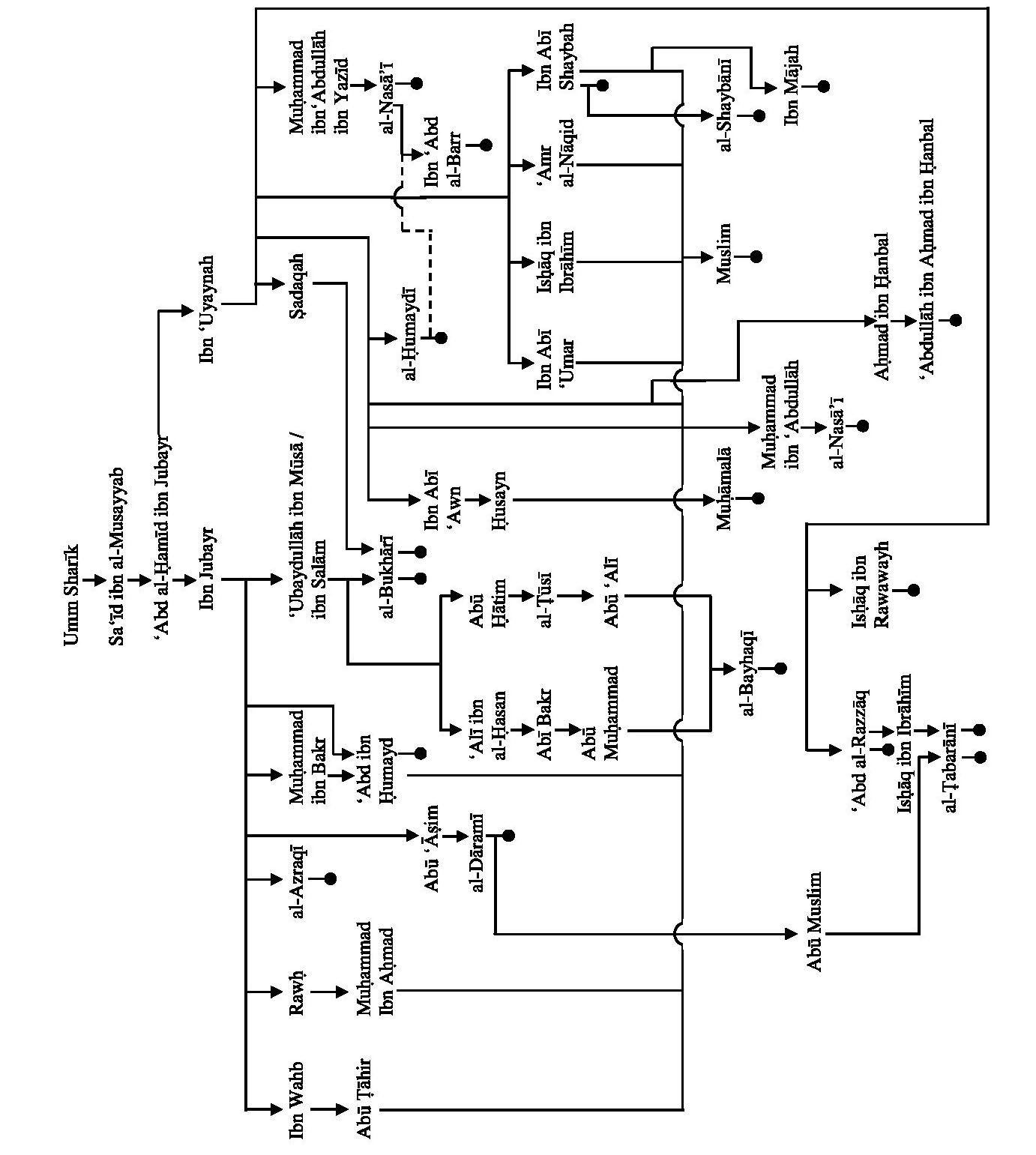
Here is a shortened form of the above illustration:
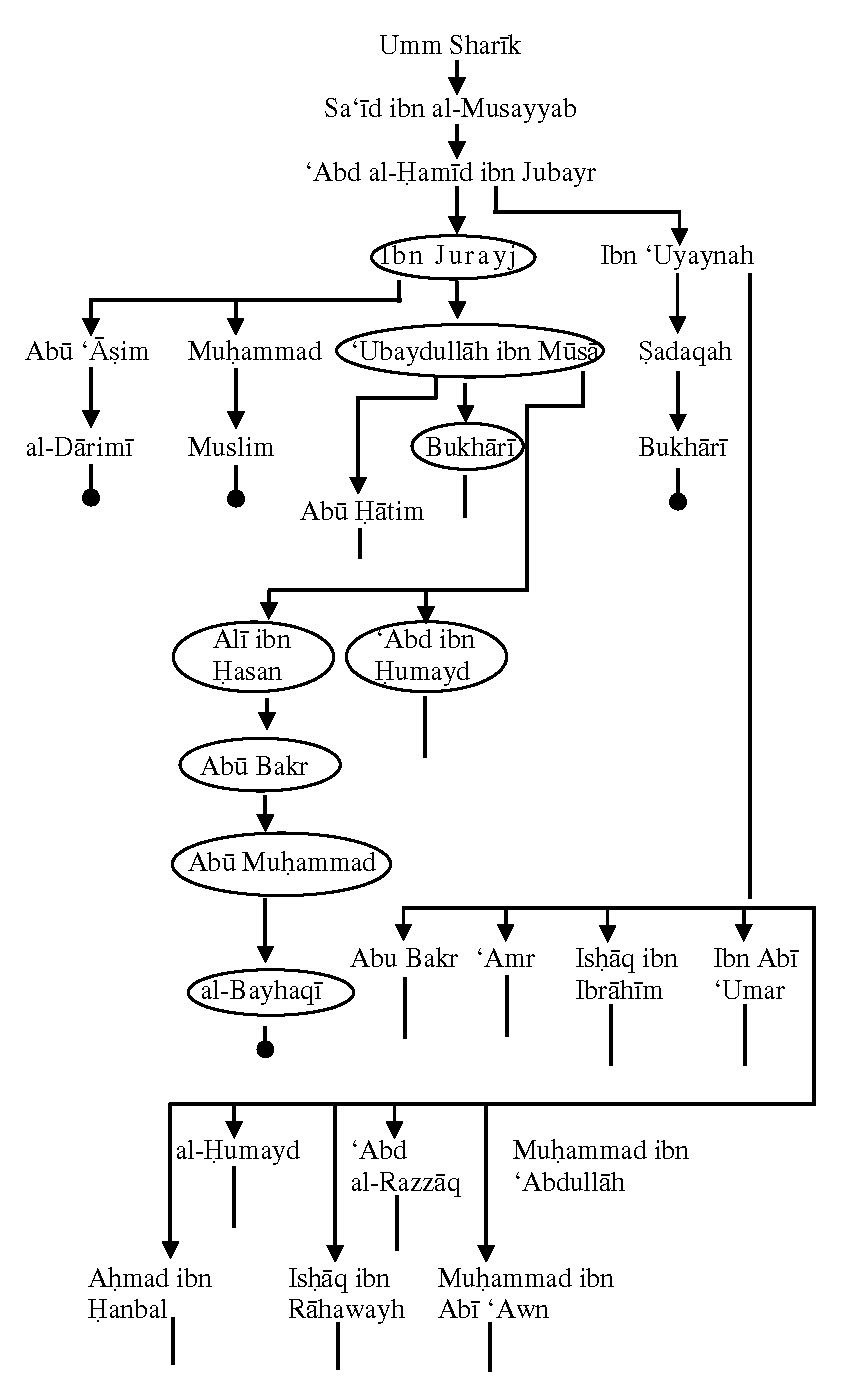
This shortened illustration is meant to
critically analyze the words كَانَ
يَنْفُخُ عَلَي اِبْرَاهِيمَ عَلَيْهِ السَّلَام
(he would blow on the fire in which Abraham was thrown) are
present in some variants of this narrative.
It is evident that two students of ‘Abd al-Hamid ibn Jubayr
report this narrative from him: Ibn Jurayj and Ibn ‘Uyaynah.
While none of the strands originating from Ibn ‘Uyaynah report
these words, only one out of the three strands originating
from Ibn Jurayj report them. Thus the strand of Abu ‘Āsim
(reported by al-Darimi) and Muhammad ibn Bakr (reported by
Muslim) are without these words, while the strand from
‘Ubaydullah ibn Musa has these words. Interestingly, in this
strand too, three out of four sub strands have these words. In
one of them in which Abu Hatim reports from ‘Ubaydullah ibn
Musa, these words are not present.
This data is enough to show the dubious nature of these words.
2. Abu Hurayrah (rta)
وَحَدَّثَنَا يَحْيَي
بْنَ يَحْيَي اَخْبَرَنَا خَالِدُ بْنُ عَبْدِ اللّٰهِ عَنْ
سُهَيْلٍ عَنْ اَبِيهِ عَنْ اَبِي هُرَيْرَةَ قَالَ قَالَ
رَسْوُلُ اللّٰهِ صَلَّي اللّٰه عَلَيْهِ وَسَلَّمَ مَنْ قَتَلَ
وَزَغَةً فِي اَوَّلِ ضَرْبَةٍ فَلَهُ كَذَا وَكَذَا حَسَنَةً
وَمَنْ قَتَلَهَا فِي الضَّرْبَةِ الثَّانِيَةِ فَلَهُ كَذَا
وَكَذَا حَسَنَةً لِدُونِ الْأُولَي وَاِنْ قَتَلَهَا فِي
الضَّرْبَةِ الثَّالِثَةِ فَلَهُ كَذَا وَكَذَا حَسَنَةً لِدُونِ
الثَّانِيَةِ
Abu Hurayrah stated that God’s Messenger (sws) said: “He who
killed a lizard in the first strike, for him is such an such
reward, and he who killed it in the second one, for him is
such and such reward less than that of the first strike and he
who killed a lizard in the third strike, for him is such and
such reward less than that of the second strike.”
Following is the schematic illustration of the isnad of this
narrative’s variants:

Though Suhayl ibn Abi Salih (d. 140 AH) is regarded to be very
trustworthy by authorities like Ahmad ibn Hanbal, al-‘Ijli and
Ibn ‘Adi, yet Yahya ibn Ma‘in’s view about him is that he is
laysa bi hujjah and in the opinion of Abu Hatim yuktabu
hadithuhu wa la yuhtajju bihi.
Al-Dhahabi records: Al-Sulami asked al-Daraqutni the reason
for al-Bukhari’s abandonment of Suhayl to which he replied
that he was not aware. Ibn Abi Khaythamah says that he heard
Yahya ibn Ma‘in say that the scholars of Hadith would continue
to abstain from his narratives; at another place, Yahya says
that he is da‘if and at still another place, his words are
laysa bi dhak.
3. Sa‘d ibn Abi Waqqas (rta)
حَدَّثَنَا اِسْحَاقُ
بْنُ اِبْرَاهِيْمَ وَعَبْدُ بْنُ حُمَيْدٍ قَالَا اَخْبَرَنَا
عَبْدَ الرَّزَّاقِ اَخْبَرَنَا مَعْمَرٌ عَنِ الزُّهْرِيِّ عَنْ
عَامِرِ بْنِ سَعْدٍ عَنْ اَبِيْهِ اَنَّ النَّبِيَّ صَلَّي
اللّٰه عَلَيْهِ وَسَلَّمَ اَمَرَ بِقَتْلِ الْوَزَغِ وَسَمَّاهُ
فُوَيْسِقًا
‘Āmir ibn Sa‘d reported from his father that the Prophet
ordered the killing of the lizard and called it a mischievous
animal.
Following is the schematic illustration of this narrative:
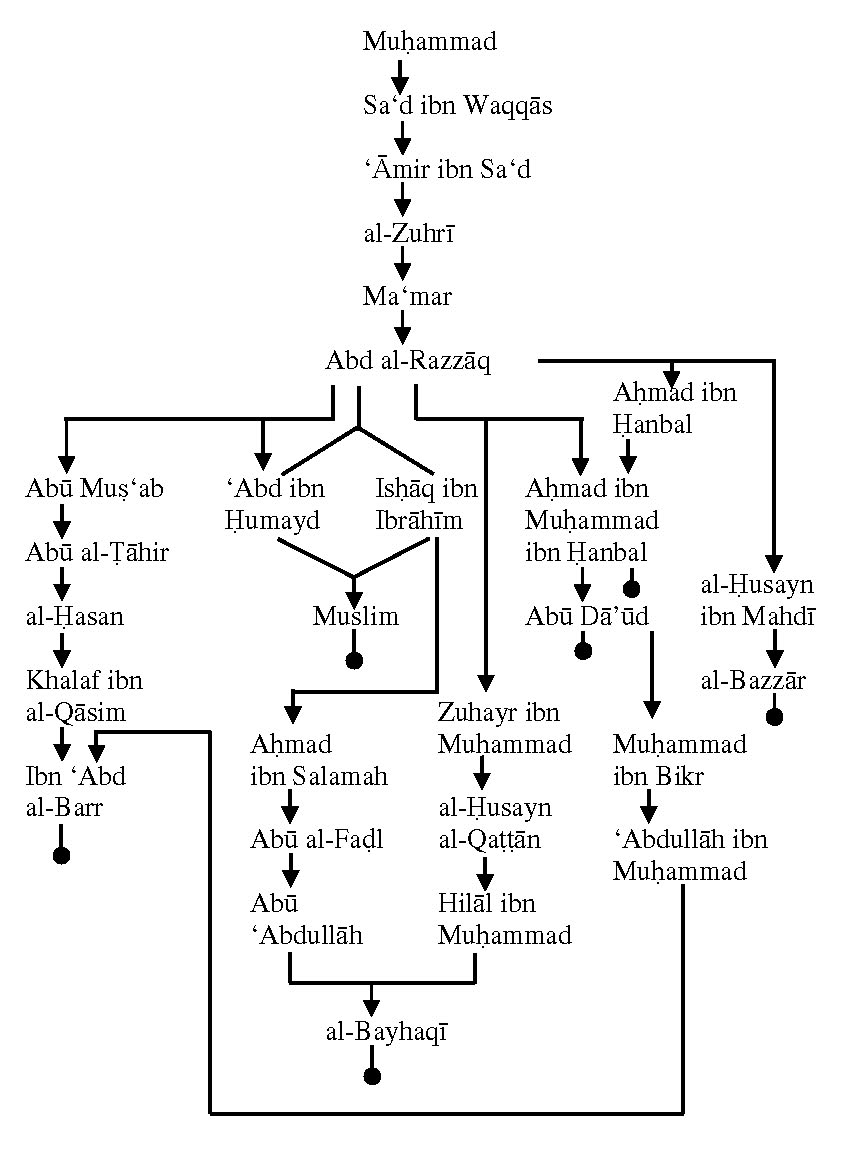
As specified by al-Bazzar, the only person to narrate this
narrative is Sa‘d from the Prophet (sws), ‘Āmir from Sa‘d, al-Zuhri
from ‘Āmir, Ma‘mar from al-Zuhri and ‘Abd al-Razzaq from
Ma‘mar.
Moreover, al-Zuhri is a known mudallis and all the variants
have his ‘an‘anah.
وصفه الشافعي و الدار
قطني و غير واحد بالتدليس
Imam al-Shafi‘i, al-Daraqutni and others have attributed
tadlis to Ibn Shihab al-Zuhri.
Imam al-Shaf‘i says:
لا نقبل من مدلس حديثا
حتی يقول فيه حدثني أو سمعت
We will not accept any narrative of any narrator unless he
says: haddathani [he narrated to me] or sami‘tu [I heard].
It may be noted that in the opinion of Imam al-Shaf‘i, if a
narrator has done tadlis just once in his life, then any of
his narratives that has ‘an‘anah will not be accepted. Ibn
Rajab al-Hanbali writes:
ولم يعتبر الشافعي أن
يتكرر التدليس من الراوي، ولا أن يغلب علي حديثه، بل اعتبر ثبوت
تدليسه، ولو بمرة واحدة.
Shafi‘i does not give regard to whether a narrator
continuously indulges in tadlis nor if his narratives are
dominated by tadlis. It is enough for him that if he has
indulged in tadlis just once in his life.
The following words of Abu Hatim recorded by al-Ka‘bi show
that Abu Hatim also regarded him to be guilty of tadlis:
قال أبو حاتم الرازى:
الزهرى أحب إلي من الأعمش، وكلاهما يحتج بحديثه فيما لم يدلسا
Abu Hatim al-Razi said: “Al-Zuhri is preferred by me over al-A‘mash
and the narratives of both can be adduced from in what both of
them are not guilty of tadlis.”
Nafi‘ (d. 117 AH) records this weakness on the part of al-Zuhri
in the following words:
وكان نافع يقول: إن
الزهري سمع أحاديث ابن عمر مني فلقي سالما فقال: هذه أحاديث
أبيك؟ قال: نعم، فرواها عن سالم وتركني.
Nafi‘ used to say: “Indeed, al-Zuhri heard from me the
narratives of ‘Abdullah ibn ‘Umar. So, when he met Salim [ibn
‘Abdullah ibn ‘Umar], he said to him: ‘Are these narratives
from your father?’ He said: ‘Yes.’ Thereafter, he narrated
them from him and stopped narrating from me.”
4. ‘Ā’ishah (rta)
i.
وَحَدَّثَنِي اَبُو
الطَّاهِرِ وَحَرْمَلَةُ قَالَا اَخْبَرَنَا بنُ وَهْبٍ
اَخْبَرَنِي يُوْنُسُ عَنِ الزُّهْرِيِّ عَنْ عُرْوَةَ عَنْ
عَائِشَةَ اَنَّ رَسُوْلَ اللّٰهِ صَلَّي اللّٰه عَلَيْهِ
وَسَلَّمَ قَالَ لِلْوَزَغِ الْفُوَيْسِقُ زَادَ حَرْمَلَةُ
قَالَتْ وَلَمْ اَسْمَعْهُ اَمَرَ بِقَتْلِهِ
‘Urwah reports from ‘Ā’ishah that God’s Messenger said that
the lizard is a mischievous animal. ‘Harmalah added that
‘Ā’ishah said: “I have not heard him order its killing.”
Following is the schematic illustration of the variants of
this narrative:

The ‘an‘anah of al-Zuhri is present in all variants.
ii.
حَدَّثَنَا اَبُو
بَكْرِ بْن اَبِي شَيْبَةَ ثنا يُونُسُ بنُ مُحَمَّدٍ عَنْ
جَرِيرِ بنِ حَازِمٍ عَنْ نَافِعٍ عَنْ سَائِبَةَ مَوْلَاةِ
الْفَاكِةِ بنِ الْمُغِيرَةِ اَنَّهَا دَخَلَتْ عَلَي عَائِشَةَ
فَرَاَتْ فِي بَيْتِهَا رُمْحًا مَوْضُوعًا فَقَالَتْ يَا اُمَّ
الْمُؤْمِنِينَ مَا تَصْنَعِينَ بِهَذَا قَالَتْ نَقْتُلُ بِهِ
هَذِهِ الْأَوْزَاغَ فَاِنَّ نَبِيَّ اللّٰهِ صَلَّي اللّٰه
عَلَيْهِ وَسَلَّمَ اَخْبَرَنَا اَنَّ اِبْرَاهِيْمَ لَمَّا
اَلْقِيَ فِي النَّارِ لَمْ تَكُنْ فِي الْأَرْضِ دَابَّةٌ
اِلَّا اَطْفَاَتْ النَّارَ غَيْرَ الْوَزَغِ فَاِنَّهَا كَانَتْ
تَنْفُخُ عَلَيْهِ فَاَمَرَ رَسُوْلُ اللّٰهِ صَلَّي اللّٰه
عَلَيْهِ وَسَلَّمَ بِقَتْلِهِ
Sa’ibah mawla al-Fakihah ibn al-Mughirah reported that she
came to ‘Ā’ishah at her house and saw that she had kept a
spear . So she said to her: “O Mother of the Faithful! What
are you doing with this?” She replied: “We have killed these
lizards through it because the Prophet of God informed us that
when Abraham was cast into the fire, every animal of the earth
except the lizard tried to put out the fire. It actually
ignited it more.”<
Following is the schematic illustration of the variants of
this narrative:
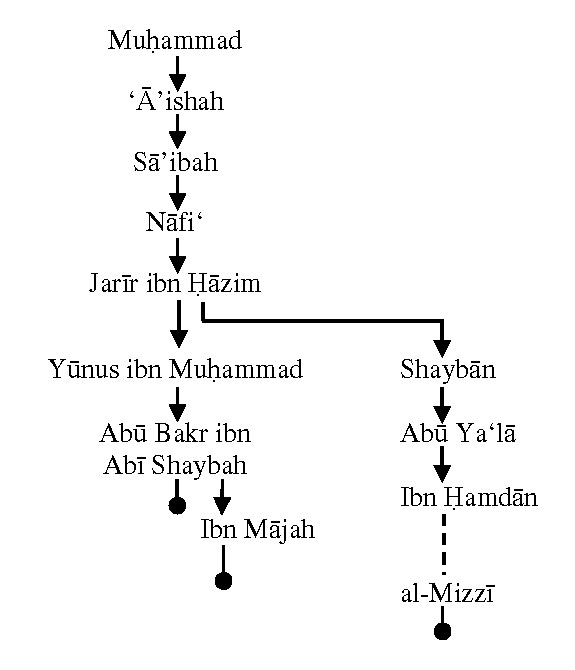
Sa’ibah mawla al-Fakihah ibn al-Mughirah is majhul al-‘ayn as
the only person to narrate from her is Nafi‘ mawla Ibn ‘Umar.
iii.
أخبرني أبو بَكْرِ بن
إسحاق قال حدثنا إِبْرَاهِيمُ بن مُحَمَّدِ بن عَرْعَرَةَ قال
حدثنا مُعَاذُ بن هِشَامٍ قال حدثني أبي عن قَتَادَةَ عن سَعِيدِ
بن الْمُسَيَّبِ أَنَّ امْرَأَةً دَخَلَتْ على عَائِشَةَ
وَبِيَدِهَا عُكَّازٌ فقالت ما هذا فقالت لِهَذِهِ الْوَزَغِ
لِأَنَّ نَبِيَّ اللَّهِ صلى الله عليه وسلم حدثنا أَنَّهُ لم
يَكُنْ شَيْءٌ إلا يُطْفِيُ علي إبراهيم عليه السَّلَام إلا هذه
الدَّابَّةُ فَأَمَرَنَا بِقَتْلِهَا
Sa‘id ibn al-Musayyab reports that a woman came to ‘Ā’ishah
who had a stick in her hand. At this, she asked: “What is
this?” So, she replied: “This is for this lizard because God’s
prophet told us that every animal tried to put out the fire
Abraham was cast into except this. Thus he ordered us to kill
it.”
Following is the schematic illustration of this narrative:
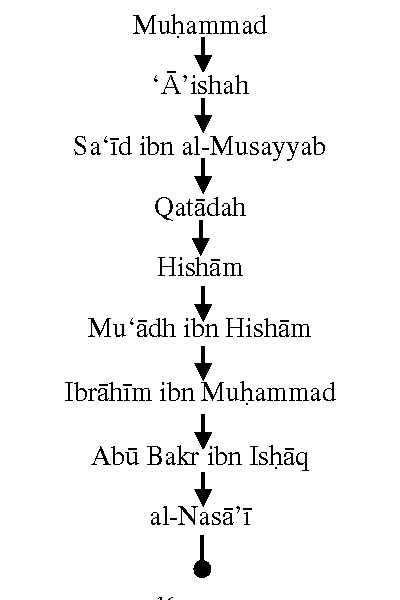
Qatadah is famous for tadlis
and the narrative has his ‘an‘anah.
About Mu‘adh ibn Hisham (d. 200 AH), Yahya ibn Ma‘in says that
he is saduq laysa bi hujjah.
iv.
عبد الرزاق قال أخبرنا
عباد بن كثير عن رجل سماه عن القاسم بن محمد عن عائشة قالت قال
رسول اللّٰه صلي اللّٰه عليه وسلم من قتل وزغا رفع اللّٰه له
تسع درجات وحط عنه تسع خطيئات قال القاسم قالت عائشة من قتل وزغا
ثم أقبل وصلي ركعتين كانت له عدل رقبة
‘Ā’ishah stated: “God’s Messenger (sws) said: ‘He who kills a
lizard, God lifts him by nine ranks and brushes away one of
his sins.’” Al-Qasim stated: “‘Ā’ishah said: ‘He who kills a
lizard and then prays two rak‘at, then this is like liberating
a slave.’”
Following is the schematic illustration of the variants of
this narrative:
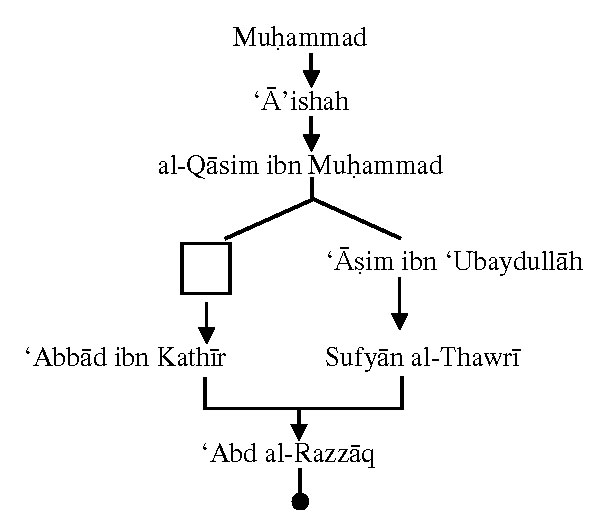
Following is the jarh recorded by al-Mizzi on ‘Āsim ibn
‘Ubaydullah ibn ‘Āsim: Ibn ‘Uyaynah said that the scholars
would abstain from his narratives. Malik says that it is so
strange that Shu‘bah is very strict in narrations but he still
narrates from a person like ‘Āsim ibn ‘Ubaydullah; Yahya ibn
Sa‘id al-Qattan and Ahmad ibn Hanbal regard him to be as weak
as ‘Abdullah ibn Muhammad ibn ‘Aqil; ‘Abd al-Rahman ibn Mahdi
regard the narratives of ‘Āsim ibn ‘Ubaydullah with severity;
Yahya ibn Ma‘in says that he is da‘if; Ibn Sa‘d says that he
is la yuhtajju bihi; Ibrahim ibn Ya‘qub al-Juzjani also
regards him to be da‘if; Ya‘qub ibn Shaybah says that there is
weakness in his narratives and that wa lahu ahadith manakir;
Abu Hatim and Muhammad ibn ‘Abdullah ibn Numayr say that he is
munkar al-hadith and mudtarib al-hadith; Al-Bukhari also
regards him to be munkar al-hadith; Ibn Khirash regards him to
be da‘if al-hadith; Abu Bakr ibn Khuzaymah says that he does
not adduce from him because of his bad memory; Al-Daraqutni
says yutrak wa huwa mughaffal.
Ibn Hibban records that he had a very bad memory, was
forgetful, made blatant errors and has been abandoned because
of abundance in his mistakes.
According to al-Saji, he is mudtatib al-hadith.
v.
عبد الرزاق عن بن عيينة
عن عبد الكريم بن أبي المخارق أن عائشة قالت قال رسول اللّٰه
صلي الله عليه وسلم من قتل وزغا كفر اللّٰه عنه سبع خطيئات
‘Ā’ishah stated: “God’s Messenger (sws) said: ‘He who kills a
lizard God forgives seven of his sins.’”
Following is the schematic illustration of the variants of
this narrative:

Al-Maqdisi regards this narrative to be da‘if.
According to Ayyub al-Sakhtiyani, ‘Abd al-Karim ibn Abi al-Makhariq
(d. 127 AH) is laysa bi shayy; Fallas says that Yahya and Ibn
Mahdi do not narrate from him; according to ‘Uthman ibn Sa‘id,
Yahya ibn Ma‘in regard him to be laysa bi shayy; Ahmad ibn
Hanbal says that he is close to being matruk; Al-Nasa’i and
al-Daraqutni regard him to be matruk.
vi.
حدثنا عبد اللّٰهِ
حدثني أبي ثنا محمد بن بَكْرٍ قال أنا بن جُرَيْجٍ قال أخبرني
عبد اللّٰهِ بن عبد الرحمن بن أبي أُمَيَّةَ إن نَافِعًا مولي بن
عُمَرَ أخبره أَنَّ عَائِشَةَ أَخْبَرَتْهُ أَنَّ النبي صلي
الله عليه وسلم قال اقْتُلُوا الْوَزَغَ فإنه كان يَنْفُخُ علي
إبراهيم عليه السَّلاَمُ النَّارَ قال وَكَانَتْ عَائِشَةُ
تَقْتُلُهُنَّ
‘Ā’ishah informed Nafi ‘ mawla Ibn ‘Umar that the Prophet
said: “Kill the lizard since it blew to ignite the fire in
which Abraham was cast.” Nafi ‘ said: “ ‘Ā’ishah used to kill
it.”
Following is the schematic illustration of the variants of
this narrative:
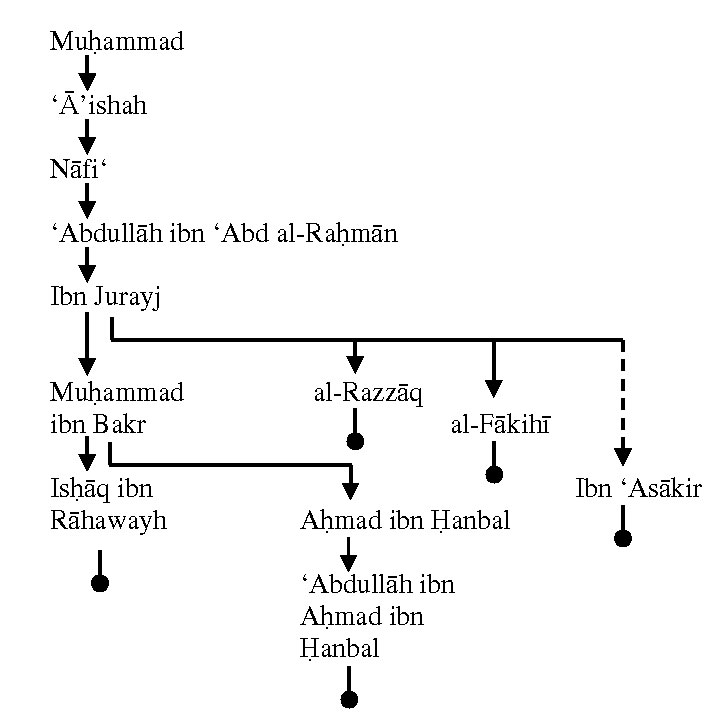
‘Abdullah ibn ‘Abd al-Rahman ibn Rabi‘ah is an unknown person.
Extant rijal books do not mention his biography at all.
5. ‘Abdullah ibn ‘Abbas (rta)
كتب ألي أبو بكر عبد
الغفار بن محمد بن الحسين البيروتي أخبرنا أبوالمحاسن عبد الرزاق
بن محمد بن أبي نصر الطبسي أنا أبو بكر عبد الغفار بن محمد بن
الحسين الشيروي أنا أبو بكر أحمد بن الحسن الحيري أنا أبو العباس
محمد بن يعقوب الأصم نا أبو محمد جعفر بن عنبسة بن عمرو بن يعقوب
اليشكري نا عمر بن حفص المكي نا ابن جريج عن عطاء عن ابن عباس
قال قيل لابن عباس هذا وزغ بعد أن عمي فقال ارشدوني إليه فارشدوه
إليه فضربه ثم قال قال رسول اللّٰه صلي اللّٰه عليه وسلم من
قتل وزغة كتبت له عشر حسنات ومحيت عنهs
عشر سيئات ورفعت له عشر درجات فقيل له يا رسول اللّٰه ما له قال
إنه أعان علي إبراهيم حيث أوقدت النار
‘Ata reported that it Ibn ‘Abbas was told: “Here is the lizard
after it has become blind. At this he said: ‘Lead me to it.’
So they led him to it. Then he hit it and said: ‘God’s
Messenger stated: “He who killed a lizard, ten pious deeds
will be written in his account and he will be lifted by ten
ranks.” God’s Messenger was asked: “Why so?” He replied: “He
would make help in the burning of Abraham by blowing on the
fire.”’”
Here is the schematic illustration of this narrative:
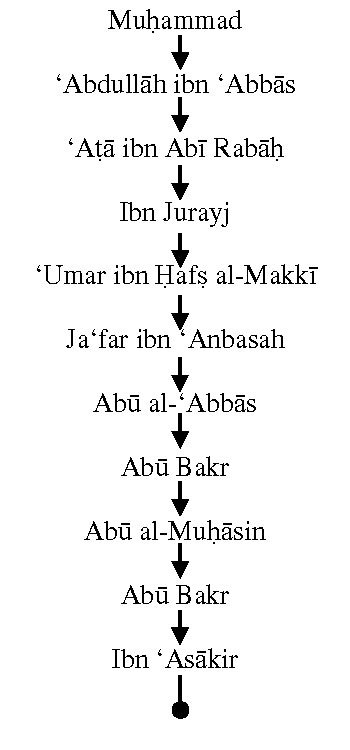
About ‘Umar ibn Hafs al-Makki, al-Dhahabi says that it is not
known who he is.
Ibn Hajar says that he is maqbul.
Al-Bayhaqi says that he is da‘if la yuhtajju bihi.
Ibn al-Qattan and al-Bayhaqi say that Ja‘far ibn ‘Anbasah ibn
‘Amr is unknown.
Critical Analysis of the Text
If all the above variants are analyzed, they can be divided
into four categories:
1. The first category
of variants says that killing lizards will earn reward from
God. No other reason is mentioned.
2. The second category
says that the reason for this extermination is that they are
mischievous animals.
3. The third category
says that the reason is because a lizard blew on the fire –
in which Abraham (sws) was thrown – thereby igniting it
further.
4. The fourth category
does not mention any killing and just reports that the lizard
was regarded as a mischievous animal.
The first category of narratives cannot be accepted. If
killing an animal is worthy of reward, there has to be some
moral reason for it.
The second category of narratives can have a basis but it can
only relate to situations where reference is to lizards that
are harmful for human beings. Not all lizards fall in this
category. Also many a time ignoring their presence makes them
harmless. Moreover, this category of narratives has more to do
with human experience and practice and nothing to the dictates
of religion.
The third category cannot be accepted since it is against the
basic precepts of reward and punishment. In the first place, a
lizard igniting the fire in which Abraham (sws) was thrown
cannot even be regarded as a sin since animals do not have
this awareness. Even more ridiculous is the fact that the
whole family of lizards be punished for at best an act done by
one member of their family.
The fourth category mentions something very plausible. Perhaps
this was the actual comment made by the Prophet (sws). Other
additions have much to do with the misunderstanding of the
narrators, their distortions and even fabrications.
ـــــــــــــــــــــــــ
|